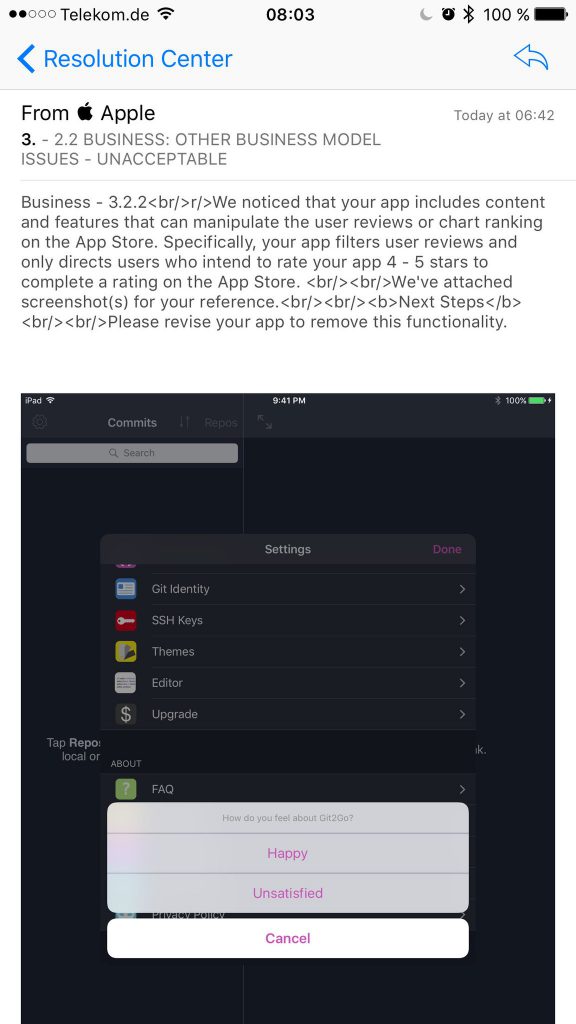Regina works at an ASO Agency called Phiture. We are looking for an ASO Consultant to join our team in Berlin.
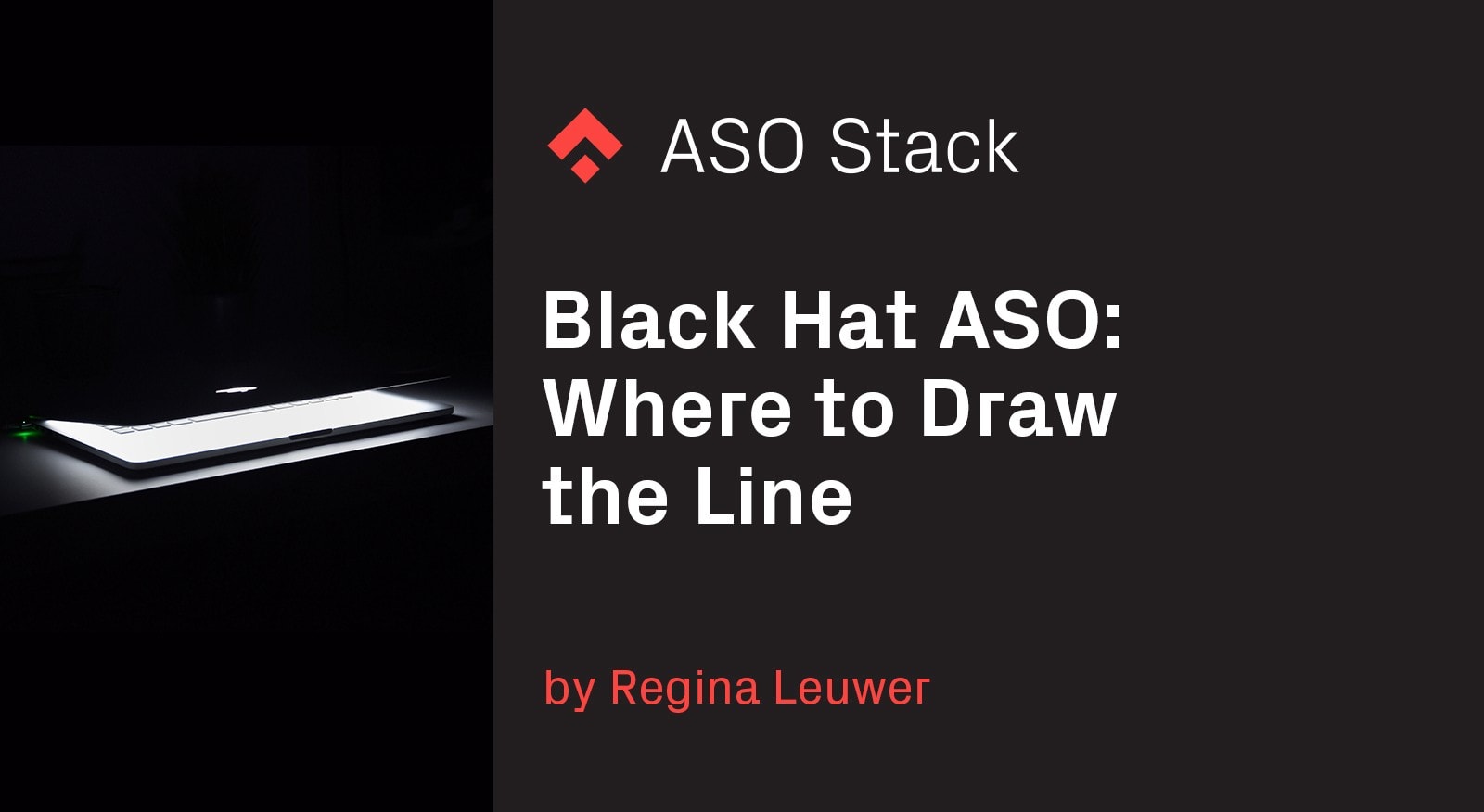
App Store Optimization is the process of improving the visibility of a mobile app in the app stores and the conversion rates of app store assets. The goal is to boost visibility and conversion while still abiding to the rules of the app stores. In contrast, Black Hat ASO disregards these rules completely and misuses optimization tactics to gain an unfair advantage.
This article aims to give an outline about which practices of Black Hat ASO are out there, how to be effective with ASO, and not miss out on traffic while at the same time steering clear of dangerous or shady tactics. It’s based on a presentation by Phiture’s Moritz Daan on the subject.
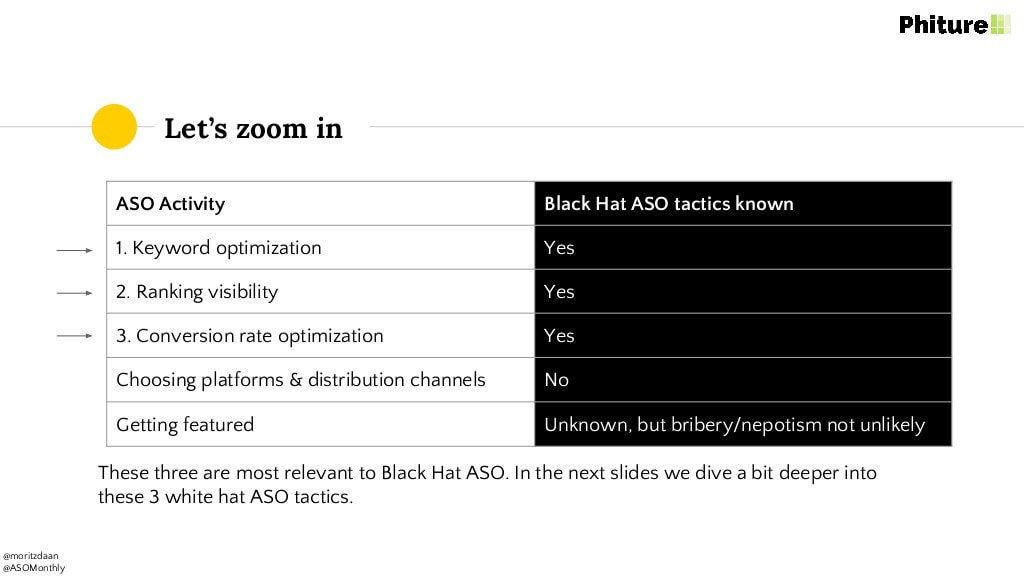
White Hat ASO tactics and their Black Hat ASO counterparts
Both Apple and Google have a set of strict guidelines and rules ( Apple App Store Guidelines and Google Play Store Guidelines) but also at other times keep it necessarily vague on what exactly is considered overstepping the line. According to Apple’s review guidelines, developers will know the line when they cross it.

Excerpt from Apple’s developer review guidelines
The app stores are relying on developers to optimize for discovery to deliver a great user experience. Apple encourages to optimize app metadata as well as the descriptive conversion factors like app title, screenshots or icon so that they can create the optimal Search Ad. They even actively seem to embrace ASO and give tips on how to optimize for search. Google Play goes one step further and provides tools like Store Listing Experiments to optimize assets, next to other useful features for conversion rate optimization (CRO).
Keyword optimization
Keyword optimization is one of the core techniques of ASO. By strategically placing keywords in an app’s title, keyword list (App Store) and description (Google Play), more users get to discover apps relevant to their interest and more apps get discovered. Mobilegrowthstack.com has covered extensively how to optimize keywords for Apple App Store and Google Play.
Other strategies can include maxing out possible app’s keywords with localization, or using trending searches for inspiration, as long as they’re relevant to the app (current trending searches can be found on Appkeywords.net).
Black Hat tactics
These are the most common Black Hat tactics around keywords:
Keyword stuffing
Stuffing in as many keywords as possible. With Apple decreasing the amount of characters in app titles to 50 they are addressing a major point which people exploited. While it is allowed to include keywords in app titles, reasonably, keyword stuffing is definitely a Black Hat move that can hurt an app’s reputation and compromise user experience.
Lifting of brand names and fake apps
Using well-known brand names and sometimes even their logos to deceive users into downloading their app instead of the original. Taking into account that, according to Google, more than half of the users are searching for a specific title, this is a widespread Black Hat tactic. Also Apple is resetting the star reviews after each update, so these fake apps simply submit a new version after getting too many negative reviews.
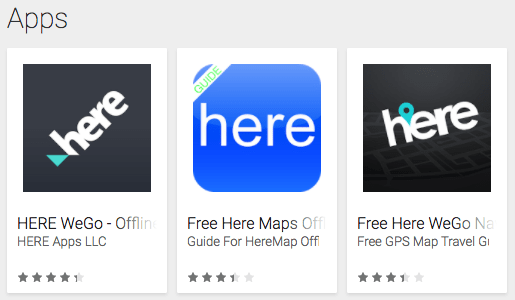
Example of fake apps next to the original
Trending Search Manipulation
A position in the trending searches can result in a significant amount of downloads from users casually browsing the App Store. This presents an opportunity for fraudulent searches which can be used to increase exposure and get short-term growth.
A slightly less aggressive, yet borderline Black Hat technique is incorporating trending search keywords that aren’t relevant to the app itself. It is also prohibited in the guidelines of both stores and can result in getting banned. But of course, it is legit to adapt an app so it becomes relevant to a trending keyword, such as “Halloween”, i.e. by changing the app temporarily to a Halloween edition.
Ranking Visibility
Apple & Google both have three top charts per category and overall:
Top Free
Top Paid/Selling
Top Grossing
Free and paid are based on downloads, grossing is based on revenue.
App store rankings are one of the major drivers for traffic and app discovery. Whether it’s ranking in the Top 100 downloaded charts or ranking within a category.
Additionally, when ranking for specific keywords that have a lot of traffic (e.g. “game”) download numbers are critical for ranking. According to Apple, the search ranking is based on text relevance (keywords, category) and user behavior (downloads, number and quality of ratings).
Increasing ranking visibility can be done by white hat tactics such as changing revenue model briefly or burst campaigns.
Black Hat tactics
Since download numbers are important as well as a quantitative measure, they’re prone to a number of Black Hat tactics:
Buying Installs and bot installs
Beginning with Fraud Installs, these practices include everything where installs will be generated by bots or where humans are paid for installs.
These installations still might result in increasing rank within a category as well as keyword rankings as the amount and velocity of installs plays a major role in both algorithms the Apple App Store as well as for Google Play. It can even get that far as pretending to be “retained” installs (fake users opening the app after X amount of time).
Incentivized installs
In 2011, Apple prominently cracked down on incentivized app installs campaigns by rejecting apps that had implemented offer walls for incentivized downloads. Today, incentivized campaigns are still around, but not as widespread. Another issue with incentivized installs is that they usually lead to a low quality user base which can hurt an app’s engagement metrics. This can be mitigated by using incentivized video ads where a view is rewarded with in-game currency but the actual download is optional.
Search & install campaigns
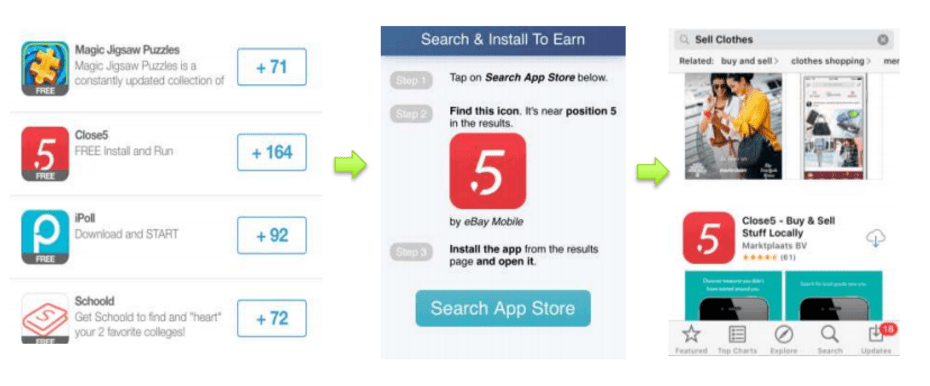
Example for a search & install campaign where users are sent to the app store via a certain query and download an app in exchange for virtual currency
Here, users are incentivized to download an app coming from a specific search query instead of directly downloading from the App Store page. This results in both a higher Click-through-rate as well as a higher amount of users that convert from this particular keyword. Also, it can affect the trending searches section if done at scale.
This practice is seen by some as Black Hat and others as Gray Hat. There are companies openly promoting these type of campaigns.
Manipulating the Top Grossing ranking
This tactic highlighted by Gabriel Machuret includes increasing the price of an app to astronomic heights and then asking friends to buy it.
The trick is to let them demand a refund right away after the transaction has been processed. This will lead to climbing on top of the top grossing charts within a category to then just change the pricing back to normal and profiting off the increased visibility due to the top grossing ranking spot.
Conversion Rate Optimization (CRO)
User reviews are one of the most important factors for app store ranking AND conversion rate optimization. The difference in terms of on-page conversion with one star more or less truly is significant, with Apptentive stating that only 50% of users are considering to install an app with a rating below 3 stars. Since the users’ incentive to rate an app is usually low and the process cumbersome (especially on iOS), developers are well-advised to proactively ask their users to leave positive reviews at the right moment in their user experience.
A common way is to ask the users to rate their experience within the app first, and then send only the happy users to the app store to leave a rating (this is called segmenting), but recently Apple seems to be taking an issue with this approach:
Black Hat tactics
There are a number of Grey- to Black Hat tactics to boost user reviews, all of which are illegal but nevertheless commonly found:
Incentivizing users for rating the app
This includes everything where the user is offered something in return for leaving a review. Apple prohibits offering for example in-app currency, content or upgrades in the app to get reviews and ratings in return. In their guidelines Apple is stating “Developers who attempt to manipulate or cheat the user reviews or chart ranking in the App Store with fake or paid reviews, or any other inappropriate methods will be removed from the iOS Developer Program.”
Buying Reviews
Buying reviews is a prohibited but very common Black Hat tactic. Normally these reviews are quite easy to recognize when taking a look at the wording. If there are a lot of reviews with almost identical wording, it’s safe to assume that these reviews are bought. It also happens that identical reviews from competitors are used.
Review contests
Since the Google Play Store indexes the keywords in user reviews there are multiple ways to incentivize them to include important keywords. This could be through making the users join a contest where they could win something in return for leaving a review.
Writing own reviews
There are many cases of app publishers writing their own reviews in both the Apple App Store as well as in the Google Play Store. Whereas Apple and Google are both getting more intelligent and starting to delete reviews that seem to be used to game the system. Keep in mind that this could ultimately result in the app getting banned from the App Stores.
Rating competitors’ apps negatively
There are many cases were publishers chose the unfair route to attack their competition. Rating the competition negatively is one of them. Needless to say, this tactic is prohibited by Apple and Google.
Closing remarks
ASO is one of the few channels app developers can fully control to make an impact. Also, it’s one of the most sustainable ways to increase incoming traffic and conversions. Any developer who deals with ASO needs to be aware of Black Hat ASO tactics as well: be it to counter unfair attacks from competitors, but also to know where to draw the line personally from White Hat to slightly ‘Grey Hat’ in order to not miss out on valuable app store traffic.

